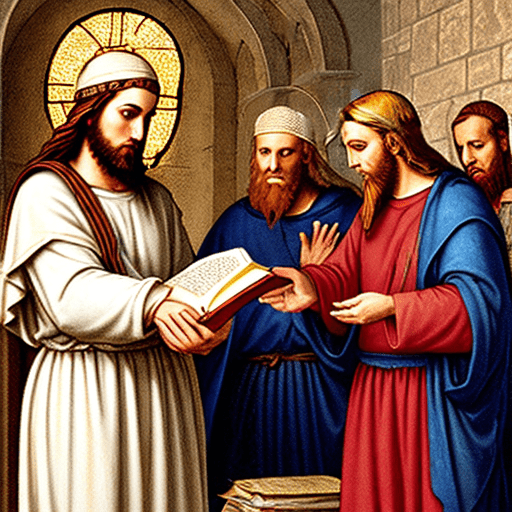“Exploring the Gospels: A Comparative Analysis of Matthew, Mark, Luke, and John”


The first four books of the New Testament, known as the Gospels, provide us with four distinct yet harmonious accounts of the life, teachings, and works of Jesus Christ. Each Gospel, while sharing a common central figure, is unique in its presentation and purpose. This article embarks on a journey to compare these four Gospels, shedding light on their individual characteristics and the unique perspectives they offer on Jesus’ story.
Section 1: Authorship and Audience
The Gospels are traditionally ascribed to four different authors, each with a unique background and audience. Matthew, once a tax collector, became a disciple of Jesus. His Gospel was primarily written for a Jewish audience, with a focus on Jesus as the prophesied Messiah. Mark, a companion of the apostle Peter, is believed to have written the earliest Gospel. His narrative is fast-paced and action-oriented, appealing to a Roman audience. Luke, a physician and companion of Paul, offers a detailed and orderly account, emphasizing Jesus as the Savior of all people, making his Gospel particularly resonant with Gentiles. Lastly, John, a beloved disciple of Jesus, presents a Gospel that stands apart from the other three. His focus is on the divine identity of Jesus, and his audience includes both Jewish and Gentile believers.
In the next sections, we will delve deeper into the structure, themes, portrayal of Jesus, unique content, parables and teachings, the passion narrative, and the use of the Old Testament in each of these Gospels.
Section 2: Chronology and Structure
The Gospels, while sharing many common events, differ significantly in their structure and chronology. Mark’s Gospel, often considered the earliest, is succinct and fast-paced. It frequently uses the term “immediately” to transition between scenes, creating a sense of urgency and immediacy.
Matthew and Luke, while generally following Mark’s narrative structure, include additional teachings and events, providing a more comprehensive view of Jesus’ life and ministry. Matthew organizes his Gospel around five major discourses or teachings of Jesus, while Luke pays particular attention to the chronological order of events.
John’s Gospel, on the other hand, takes a different approach. It focuses less on the chronological sequence of events and more on the thematic elements of Jesus’ life and ministry. A significant portion of John’s Gospel is dedicated to the final week of Jesus’ life, providing a detailed account of His teachings and interactions during that pivotal time.
Section 3: Themes and Emphasis
Each Gospel carries its unique themes and emphasis, shaping our understanding of Jesus’ life and mission. Matthew presents Jesus as the King and promised Messiah, fulfilling Old Testament prophecies. His Gospel is rich with references to the Old Testament, demonstrating how Jesus fulfills these ancient prophecies.
Mark portrays Jesus as a servant who acts decisively. His Gospel emphasizes Jesus’ deeds, particularly His miracles, demonstrating His authority and compassion.
Luke presents Jesus as the compassionate Savior of all people. His Gospel highlights Jesus’ interactions with various societal outcasts – sinners, tax collectors, the poor, and women, showcasing Jesus’ inclusive love and compassion.
John underscores Jesus’ divine nature. His Gospel focuses on Jesus’ profound teachings and the signs He performed, which reveal His divine identity and mission.
Section 4: Portrayal of Jesus
The portrayal of Jesus varies in each Gospel, reflecting the unique themes and emphasis of the respective authors. In Matthew, Jesus is depicted as the promised Messiah and King, fulfilling the Old Testament prophecies. His genealogy traces back to Abraham and David, emphasizing his royal lineage and Jewish roots.
Mark’s Gospel portrays Jesus as a man of action, a servant who is always on the move. Despite his divine authority, Jesus is depicted as humble and compassionate, often moved by the needs of the people he encounters.
Luke presents Jesus as the compassionate Savior whose love and mercy extend to all people, regardless of their social status or ethnicity. His Gospel emphasizes Jesus’ interactions with the marginalized, including women, children, tax collectors, and sinners.
John’s Gospel offers a high Christology, portraying Jesus as the divine Word made flesh. His Gospel emphasizes Jesus’ divine nature and his pre-existence before the creation of the world.
Section 5: Unique Content
Each Gospel contains unique content that is not found in the others. For instance, the Sermon on the Mount and the parables of the Kingdom are unique to Matthew. Mark, while being the shortest Gospel, includes some unique details, such as the healing of the blind man at Bethsaida.
Luke’s Gospel is rich with unique parables, including the Good Samaritan and the Prodigal Son. It also provides a detailed account of Jesus’ birth and childhood, which is absent in the other Gospels.
John’s Gospel stands out with its unique content. It includes the “I am” statements of Jesus, the detailed discourses, and the signs that Jesus performed to reveal his divine identity.
Just a note:
The miracle that is mentioned in all four Gospels is the feeding of the 5000. This is the only miracle, apart from the resurrection, that appears in Matthew, Mark, Luke, and John. It’s a significant event where Jesus feeds a large crowd with only five loaves of bread and two fish. You can find the accounts in the following passages:
- Matthew 14:13-21
- Mark 6:31-44
- Luke 9:10-17
- John 6:5-15
Section 6: Parables and Teachings
The parables and teachings of Jesus form a significant part of the Gospels. Matthew’s Gospel is rich with Jesus’ teachings, including the Sermon on the Mount, which contains the Beatitudes and the Lord’s Prayer. Matthew also includes several kingdom parables, such as the Parable of the Sower and the Parable of the Weeds.
Mark’s Gospel, while shorter, includes vital teachings of Jesus, such as the commandment to love God and neighbor as the greatest of all commandments. It also contains parables, including the Parable of the Mustard Seed, illustrating the Kingdom of God.
Luke’s Gospel is known for its unique parables, such as the Good Samaritan and the Prodigal Son. These parables highlight the themes of mercy, forgiveness, and the inclusive nature of God’s Kingdom.
John’s Gospel does not contain parables in the traditional sense. Instead, it includes extended metaphoric discourses, such as Jesus declaring Himself as the “bread of life” and the “true vine.”
Section 7: The Passion Narrative
The accounts of Jesus’ death and resurrection, also known as the Passion narrative, vary in each Gospel. While all four Gospels describe the basic events leading to Jesus’ crucifixion and His subsequent resurrection, they offer different perspectives and details.
For example, only in Matthew’s Gospel does Pilate’s wife warn her husband about Jesus, and the centurion declare, “Truly this was the Son of God!” Mark’s Gospel ends abruptly with the women finding the empty tomb, while Luke includes the detailed account of Jesus’ appearance on the road to Emmaus. John’s Gospel provides a unique account of Jesus’ interactions with Pilate and His mother’s presence at the cross.
Section 8: Use of Old Testament
The use of the Old Testament also varies among the Gospels. Matthew frequently quotes the Old Testament to show how Jesus fulfills the Messianic prophecies. Mark, writing for a Roman audience, uses fewer Old Testament references. Luke, while using the Old Testament, often does so in the words of characters in his Gospel, such as Zechariah, Mary, Simeon, and Jesus. John’s Gospel, while not quoting the Old Testament as frequently, uses it significantly in the discourses of Jesus.
In conclusion, while the four Gospels share the common goal of narrating the life, death, and resurrection of Jesus Christ, they each offer a unique perspective, enriching our understanding of the multifaceted nature of Jesus’ life and mission. By comparing these Gospels, we can gain a deeper appreciation for the richness and depth of the biblical account of Jesus.

